医学科技论文写作 (1)
- 格式:ppt
- 大小:7.56 MB
- 文档页数:25
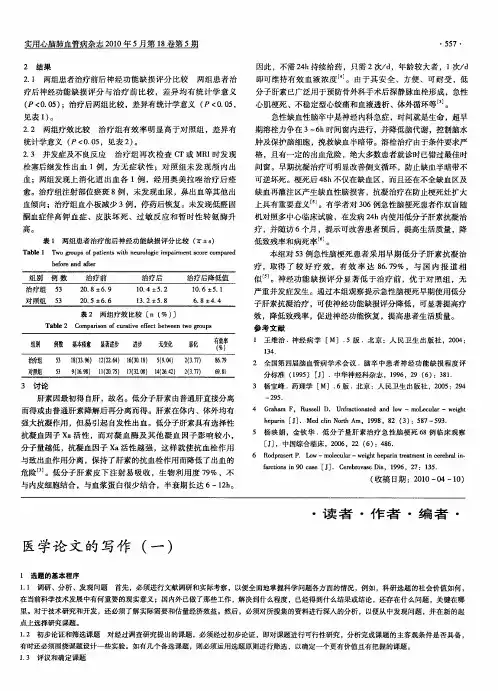
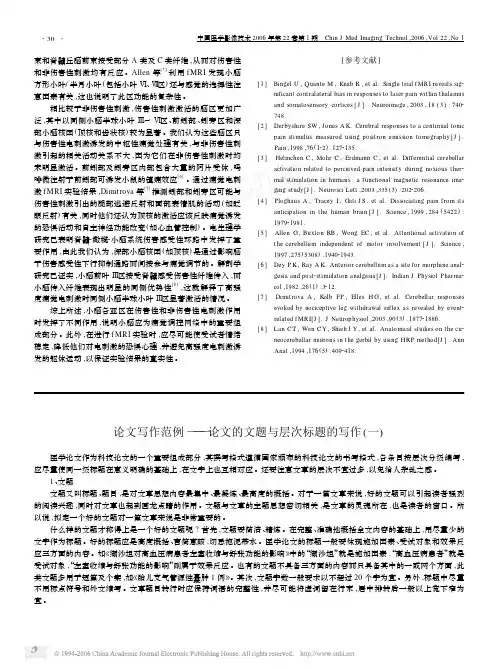
束和脊髓丘脑前束接受部分A 类及C 类纤维,从而对伤害性和非伤害性刺激均有反应。
Allen 等[5]利用f MRI 发现小脑方形小叶/半月小叶(包括小叶Ⅵ、Ⅶ区)还与感觉的选择性注意因素有关,这也说明了此区功能的复杂性。
相比较于非伤害性刺激,伤害性刺激激活的脑区更加广泛,其中以同侧小脑半球小叶Ⅲ~Ⅵ区、前蚓部、蚓旁区和深部小脑核团(顶核和齿状核)较为显著。
我们认为这些脑区只与伤害性电刺激诱发的中枢性痛觉处理有关,与非伤害性刺激引起的相关活动关系不大,因为它们在非伤害性刺激时均未明显激活。
前蚓部及蚓旁区内部包含大量的阿片受体,吗啡微注射于前蚓部可诱发小鼠的镇痛效应[6]。
通过痛觉电刺激f MRI 实验结果,Dimitrova 等[7]推测蚓部和蚓旁区可能与伤害性刺激引出的腿部逃避反射和面部表情肌的活动(如眨眼反射)有关,同时他们还认为顶核的激活应该反映痛觉诱发的恐惧活动和自主神经功能改变(如心血管控制)。
电生理学研究已表明脊髓2橄榄2小脑系统伤害感受性环路中发挥了重要作用,由此我们认为,深部小脑核团(如顶核)是通过影响脑干伤害感受性下行抑制通路而间接参与痛觉调节的。
解剖学研究已证实,小脑前叶Ⅲ区接受脊髓感受伤害性纤维传入,而小脑传入纤维表现出明显的同侧优势性[8],这就解释了高强度痛觉电刺激时同侧小脑半球小叶Ⅲ区显著激活的情况。
综上所述,小脑各亚区在伤害性和非伤害性电刺激作用时发挥了不同作用,说明小脑应为痛觉调控网络中的重要组成部分。
此外,在进行f MRI 实验时,应尽可能使受试者情绪稳定,降低他们对电刺激的恐惧心理,并避免高强度电刺激诱发的躯体运动,以保证实验结果的真实性。
[参考文献][1] Bingel U ,Quante M ,Knab R ,et al.Single trial fMRI reveals sig 2nificant contralateral bias in responses to laser pain wit hin t halamus and somatosensory cortices [J ].Neuroimage ,2003,18(3):7402748.[2] Derbyshire SW ,Jones A K.Cerebral responses to a continual tonicpain stimulus measured using positron emission tomography [J ].Pain ,1998,76(122):1272135.[3] Helmchen C ,Mohr C ,Erdmann C ,et al.Differential cerebellaractivation related to perceived pain intensity during noxious t her 2mal stimulation in humans :a functional magnetic resonance ima 2ging study[J ].Neurosci Lett ,2003,335(3):2022206.[4] Ploghaus A ,Tracey I ,Gati J S ,et al.Dissociating pain from it santicipation in t he human brain [J ].Science ,1999,284(5422):197921981.[5] Allen G ,Buxton RB ,Wong EC ,et al.Attentional activation oft he cerebellum independent of motor involvement [J ].Science ,1997,275(5308):194021943.[6] Dey P K ,Ray A K.Anterior cerebellum as a site for morphine anal 2gesia and post 2stimulation analgesia [J ].Indian J Physiol Pharma 2col ,1982,26(1):3212.[7] Dimitrova A ,K olb FP ,Elles H G ,et al.Cerebellar responsesevoked by nociceptive leg wit hdrawal reflex as revealed by event 2related f MRI[J ].J Neurophysiol ,2003,90(3):187721886.[8] Lan CT ,Wen CY ,Shieh J Y ,et al.Anatomical studies on t he cu 2neocerebellar neurons in t he gerbil by using HRP met hod[J ].Ann Anat ,1994,176(5):4092418.论文写作范例———论文的文题与层次标题的写作(一)医学论文作为科技论文的一个重要组成部分,其撰写格式遵循国家颁布的科技论文的书写格式,各条目按层次分级编写,应尽量使同一级标题在意义明确的基础上,在文字上也互相对应。
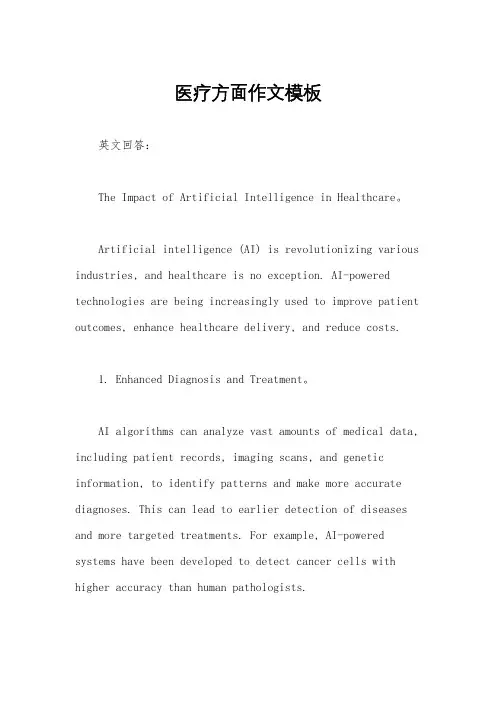
医疗方面作文模板英文回答:The Impact of Artificial Intelligence in Healthcare。
Artificial intelligence (AI) is revolutionizing various industries, and healthcare is no exception. AI-powered technologies are being increasingly used to improve patient outcomes, enhance healthcare delivery, and reduce costs.1. Enhanced Diagnosis and Treatment。
AI algorithms can analyze vast amounts of medical data, including patient records, imaging scans, and genetic information, to identify patterns and make more accurate diagnoses. This can lead to earlier detection of diseases and more targeted treatments. For example, AI-powered systems have been developed to detect cancer cells with higher accuracy than human pathologists.2. Personalized Medicine。
AI can help create personalized treatment plans for each patient based on their individual characteristics and medical history. By analyzing genetic data, lifestyle choices, and environmental factors, AI algorithms can predict the likelihood of developing certain diseases and recommend appropriate preventive measures. This approach can lead to more effective and individualized healthcare.3. Remote Healthcare。
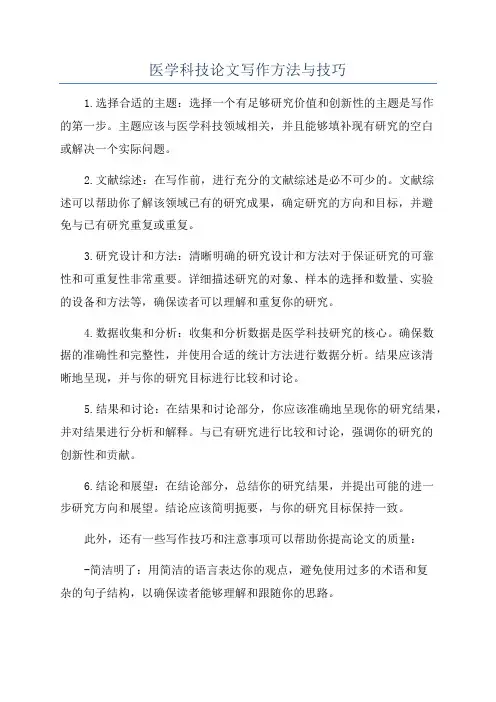
医学科技论文写作方法与技巧1.选择合适的主题:选择一个有足够研究价值和创新性的主题是写作的第一步。
主题应该与医学科技领域相关,并且能够填补现有研究的空白或解决一个实际问题。
2.文献综述:在写作前,进行充分的文献综述是必不可少的。
文献综述可以帮助你了解该领域已有的研究成果,确定研究的方向和目标,并避免与已有研究重复或重复。
3.研究设计和方法:清晰明确的研究设计和方法对于保证研究的可靠性和可重复性非常重要。
详细描述研究的对象、样本的选择和数量、实验的设备和方法等,确保读者可以理解和重复你的研究。
4.数据收集和分析:收集和分析数据是医学科技研究的核心。
确保数据的准确性和完整性,并使用合适的统计方法进行数据分析。
结果应该清晰地呈现,并与你的研究目标进行比较和讨论。
5.结果和讨论:在结果和讨论部分,你应该准确地呈现你的研究结果,并对结果进行分析和解释。
与已有研究进行比较和讨论,强调你的研究的创新性和贡献。
6.结论和展望:在结论部分,总结你的研究结果,并提出可能的进一步研究方向和展望。
结论应该简明扼要,与你的研究目标保持一致。
此外,还有一些写作技巧和注意事项可以帮助你提高论文的质量:-简洁明了:用简洁的语言表达你的观点,避免使用过多的术语和复杂的句子结构,以确保读者能够理解和跟随你的思路。
-逻辑清晰:在写作过程中,确保你的论文逻辑结构清晰,每个段落都有明确的主题句和支持句。
-细节精确:在描述实验设计、方法和结果时,提供足够的细节,以确保读者可以理解和重复你的研究。
-修订和修改:完成初稿后,进行仔细的修订和修改。
检查语法错误、句子结构、拼写错误等,确保你的论文没有任何错误。
-请他人审阅:请其他人审阅你的论文,并提供反馈意见。
他们可以帮助你发现你可能忽视的错误或改进的地方。
总之,写作一篇高质量的医学科技论文需要充分的准备和仔细的思考。
遵循以上的方法和技巧,你可以写出一篇清晰、准确、有逻辑性的医学科技论文。
同时,不断的练习和反复修改也是提高论文写作水平的重要途径。
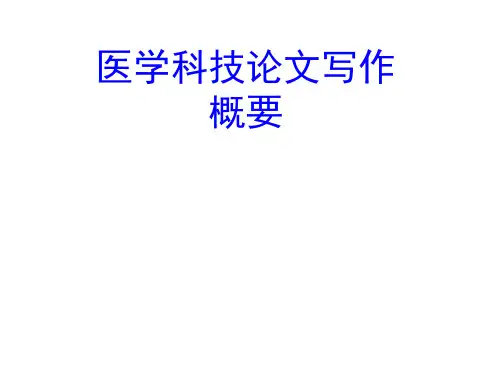
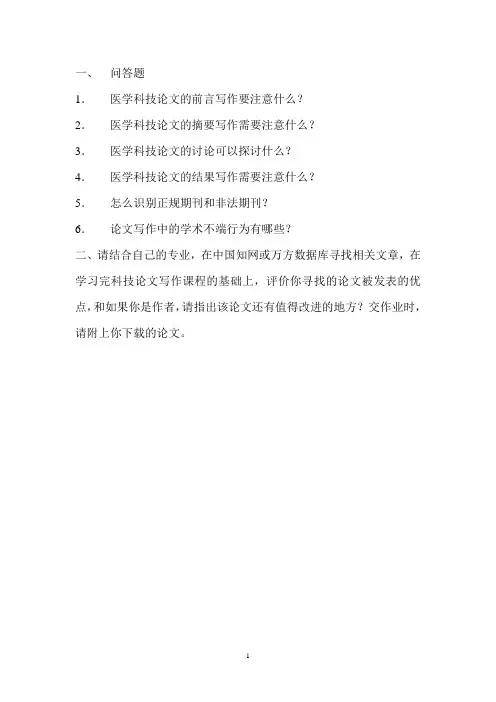
一、问答题
1.医学科技论文的前言写作要注意什么?
2.医学科技论文的摘要写作需要注意什么?
3.医学科技论文的讨论可以探讨什么?
4.医学科技论文的结果写作需要注意什么?
5.怎么识别正规期刊和非法期刊?
6.论文写作中的学术不端行为有哪些?
二、请结合自己的专业,在中国知网或万方数据库寻找相关文章,在学习完科技论文写作课程的基础上,评价你寻找的论文被发表的优点,和如果你是作者,请指出该论文还有值得改进的地方?交作业时,请附上你下载的论文。
1。
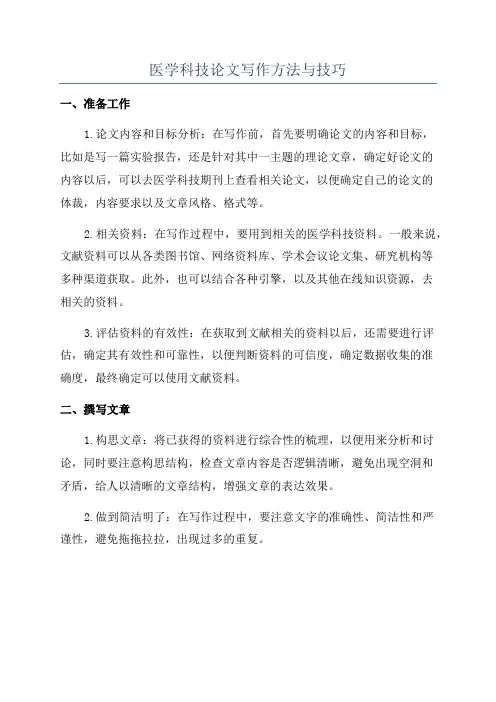
医学科技论文写作方法与技巧
一、准备工作
1.论文内容和目标分析:在写作前,首先要明确论文的内容和目标,
比如是写一篇实验报告,还是针对其中一主题的理论文章,确定好论文的
内容以后,可以去医学科技期刊上查看相关论文,以便确定自己的论文的
体裁,内容要求以及文章风格、格式等。
2.相关资料:在写作过程中,要用到相关的医学科技资料。
一般来说,文献资料可以从各类图书馆、网络资料库、学术会议论文集、研究机构等
多种渠道获取。
此外,也可以结合各种引擎,以及其他在线知识资源,去
相关的资料。
3.评估资料的有效性:在获取到文献相关的资料以后,还需要进行评估,确定其有效性和可靠性,以便判断资料的可信度,确定数据收集的准
确度,最终确定可以使用文献资料。
二、撰写文章
1.构思文章:将已获得的资料进行综合性的梳理,以便用来分析和讨论,同时要注意构思结构,检查文章内容是否逻辑清晰,避免出现空洞和
矛盾,给人以清晰的文章结构,增强文章的表达效果。
2.做到简洁明了:在写作过程中,要注意文字的准确性、简洁性和严
谨性,避免拖拖拉拉,出现过多的重复。

如何发表医学SCI论文写作及技巧英文医学论文(medical papers)的定义医学论文是对整理和发表医学研究成果的一种特殊文本的总称,就其内容和文体特点而言科分为以下几种:1.医学科研论文(scientific papers)2.调查报告(survey)3.综述(review)4.学位论文(theses)5.医学科研论文(scientific papers)医学科研论文定义国际生物学编辑委员会对医学科研论文的定义为:必须是首次公布的应提供足够的资料,使同行们能够进行:①评价所观察到的结果;②评价其推理过程;③重复实验。
分为以下两种:①临床研究(clinical study);②基础研究或实验研究(experimental study)医学科研论文的格式(1)标题(title)(2)摘要(abstract)(3)引言(introduction)(4)材料和方法(materials and methods)(5)结果(results)(6)讨论(discussion)(7)致谢(acknowledgement)(8)参考文献(references)一、标题(一)要求1.简明扼要(short and concise)(1)尽量控制在一行,但不是一个句子(2)不超过25个单词或120-140个字母(3)除DNA、RNA、CT等不用缩写2.信息丰富(informative)3.便于索引(indexing)4.较长标题可采用副标题(二)标题写作中常用词组和表达方式1.用…(方法/手段)对…进行研究/分析/观察/评价:Study(analysis/observation/evaluation/assessment) of (on) …(by) using 方法/with工具)2.A对B的作用Effort of A on BProtective effect of omeprazole on endothelin-induced gastric mucosal injury3.A与B的关系Correlation (relation/relationship) between A and BCorrelation of A with B and C常用修饰词:positively/negatively/significantly/insignificantly4.用…治疗…Use of …in the treatment of …(病)in …(生物)Use of omeprazole in the treatment of gastric ulcer in the elderly5.A是B A as B二、著录部分书写(一)姓名标准式:WANG aobang,HUANG aobang,GUO Xiao’an (二)地址800 Xiang Yin Road, Shanghai 200433, P.R.China(三)资助A project funded by the National “863” Program三、摘要的分类与格式摘要是作者要给读者的精华,分两大类:(一)指示性摘要(二)资料性摘要1.非结构式摘要缺点:段落不明,给编辑、审稿、阅读和计算机处理带来诸多不便2.全结构式摘要(8要素摘要)(1)目的(2)设计(3)地点(4)对象(5)处理(6)主要测定项目(7)结果(8)结论全结构式摘要的优点(1)观点更明确(2)信息量更大(3)差错更少(4)符合计算机数据库建立和使用的要求全结构式摘要的缺点:烦琐、重复、篇幅过长3.半结构式摘要(四要素摘要)(1)目的(objective/purpose/aim)(2)方法(methods)(3)结果(results)(4)结论(conclusion)目的:是作者想要介绍的关键问题一、目的格式(一)单表目的(二)背景+目的二、目的常用时态(一)背景:现在时(一般现在时、完成时和进行时)(二)目的:一般现在时/现在完成时,或一般过去时举例:(1)To evaluate the effects on 24-hour intragastric pH levels of infusions with omeprazole and H2 receptor antagonists in bleeding duodenal ulcer patients.(2)The role of omeprazole in triple therapy and the impact of Helicobacter pylori resistance on treatment outcome are not established. This study investigated the role of omeprazole and influence of primary H. pylori resistance on eradication and development of secondary resistance.三、介绍目的常用句型主要用动词不定式to表达1.直接用to do短语表达举例:To determine if use of omeprazole protects against the gastric mucosal injury2.The purpose/aim/objective/goal(of present study is)was to举例:The aim of this study was to determine the protective function of omeprazole on gastric mucosal injury3.The present study is /was designed/devised/intended to举例:The present study was designed to establish whether there might be a genetic predisposition to an altered pattern of anti-inflammatory cytokine produced in patients with irritable bowel syndrome4.This study was performed/conducted/carried out/undertaken to举例:An experimental study was conducted using a canine mode toelucidate …5.We aimed/sought to/attempted to举例:We sought to assess whether there is an increased risk of tuberculosis among individuals who work in certain industries occupations.四、介绍目的常用动词1.研究:study, investigate, examine, observe, explore举例:Our objective in this report is to examine the clinical feature, pathology and treatment for patients with pancreatic cancer.2.评价:evaluate, validate举例:To evaluate sonography as a tool for initial diagnosis in emergency room patients with abdominal trauma.3.确定:determine, decide, confirm, support, define, characterize4.证实:prove, demonstrate, document, test, support, testify, verify5.阐明、搞清:explain, elucidate, clarify, illustrate, delineate, find out, contribute to the knowledge of6.介绍:describe, present, report7.建立:establish, develop, set out8.寻找:search for, look for, seek, find9.识别、区分:identify, differentiate, discriminate10.优选:optimize11.比较:compare12.回顾:review13.相关:correlate A with B方法部分(1)研究设计(2)研究对象的特性(3)干预或处理方法(4)测定或观察方法一、研究对象的选择、来源及标准1.纳入研究:were entered into/enrolled in/selected (randomly)举例:A total of 169 patients were included in the study, 83 of whom received……2.排除或退出研究:were excluded from participation,withdrew from the study due to/because to举例:……Patients with significant aortic valvular diseases were excluded.二、研究对象的分组1.……were divided into/classified/grouped into2.……were divided randomly/randomized into3.……were divided equally into举例:Patients were divided into three groups: Group 1……Patients (n = 539) with a history of duodenal ulcer and a positive H. pylori screening test result were randomized into 4 groups. OAC group received 20 mg omeprazole, ……三、年龄1.某一年龄举例:A 50-year-old patient. Patients (age 26±3 years).2.在某年龄范围内及平均年龄举例:Patients range in age from …to…, with a mean of (50 years).3.在某一年龄以上或以下举例:Patients more than 50 years. Patients under/less than 50 years.四、性别、时间1.性别twelve patients (7 male and 5 female )The male-to-female ratio was 1:42.时间Body weight was measured weekly, and liver biopsy was obtained at 4, 8 and 12 weeks. ……五、诊断与治疗1.诊断be diagnosed as having …be diagnosed as …by …/with …®be suspected as …2.治疗be treated with…(alone or in combination with …)be treated on outpatient/inpatient basis举例:(1)Patients (n = 539) with a history of duodenal ulcer and a positive H. pylori screening test result were randomized into 4groups. OAC group received 20 mg omeprazole,…(2)50 patients with active bleeding duodenal ulcer were randomly assigned to receive one of the four treatment regimens. …结果部分1.是文章结论的根据2.应记录真实的科研数据3.除指示性说明外,一般用过去时表示一、常用句型1.结果表明:The results showed / demonstrated / revealed / documented / indicated/suggested…that…®It was found that…举例:The results showed that high thigh cuff Doppler technique was 79 percent sensitive, 56 percent specific and 63 percent accurate.2.与…有关:A was related / correlated /associated with B. There was a relationship /correlation between A and B. There was a relation of A with B and C举例:Insulin sensitivity index was negatively with blood velocity (r=0.530,P<0.05), body mass index (r=o.563, P<0.01) and baseline insulinemia (r=0.489,P<0.05)3.增加或减少(1)表示数值增加的动词:increase, rise, elevate(2)表示数值增加的名词:increase, increment, elevation(3)表示数值减少的动词:decrease, reduce, fall, drop, decline, lower(4)表示数值减少的名词:decrease, decrement, reduction, fall, drop, decline, lowering(5)从…增加到…,平均增加…:increase from …to …, with a mean/average (increase) of …(6)从…增加到…,总的增加…:increase from …to …, with an overall increase of …(7)增加了10%:increase by (10%)4.倍数比较(1)增加或减少3倍:increase by 3 fold (times). a 3-fold increase(2)A 是B的3倍:A is 3 fold (times) as…as B. A is 3 fold (times) B5.结果的统计学意义(1)明显不同(significant difference)(2)很明显不同(very/highly significant difference)(3)区别不明显(insignificant difference)(4)无区别(nonsignificant difference/no difference)6.统计学意义常用句型(1)There was/is significant difference in…between A and B(2)The difference in …between A and B was/is significant(3)A was/is significant difference from B in …(4)No significant difference was found / observed / noted in …between A and B“in”表示区分的性质或内容举例:①There were no significant difference between treatment groups in symptoms and lung function (P>0.05).②Significant difference were not noted in the level of HDL cholesterol, and LDL peak particle diameter before and after treatment.结论部分:是作者发表观点和见解,给读者的精髓部分1.归纳性说明研究结果或发现2.结论性说明结果的可能原因、机理或意义3.前瞻性说明未解决的问题一、结论部分时态1.过去时(1)涉及本研究的内容(2)涉及他人研究过程的内容(3)作者认为只适用于本研究环境和条件的结论2.现在时(1)指示性说明(2)普遍接受的思想、理论或结论(3)作者认为本研究结论具有普遍意义(4)前瞻性说明举例:Our findings indicate that hepatitis C is a progressive disease [指示性说明-现在时],but only a few died during the average 20.4 years after the initiation of injection drug use [本试验过程中发生的事-过去时]. Antiviral treatment to eradicate the virus and halt the progression of diseases is indicated in this group of patients [作者认为具有普遍意义的结论-现在时].二、结论部分常用句型1.结果提示…:These results suggest that…举例:These data confirm the presence of at least two major HCV genotypes in Nigeria.2.结果支持或反对某种观点:These results support the idea that…;These results fail to support the idea that…举例:These results do not support the idea that treatment to lower cholesterol concentration cause mood disturbance.3.表示观点的确定或不确定性:There is no evidence that…;It is likely/unlikely that …举例:There is no evidence that NIDDM produce any change in bone metabolism or mass.4.具有…意义:Be of great (some/little/no) clinical significance in…to …举例:The detection of p53 gene is of great clinical significance in tumor diagnosis.5.前瞻性说明:…remain to be further studied;It is remains to be proved that …举例:However, the relation of insulin resistance to hypertension remains to be further studied.6.插入语:This is the first case of pancreas divisum.举例:This is the first case, to our knowledge, of pancreas divisum.小结中文是关键符合英语习惯不用简单句注意词语的用法注意时态。
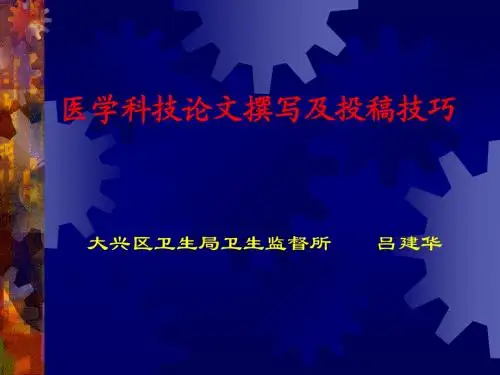
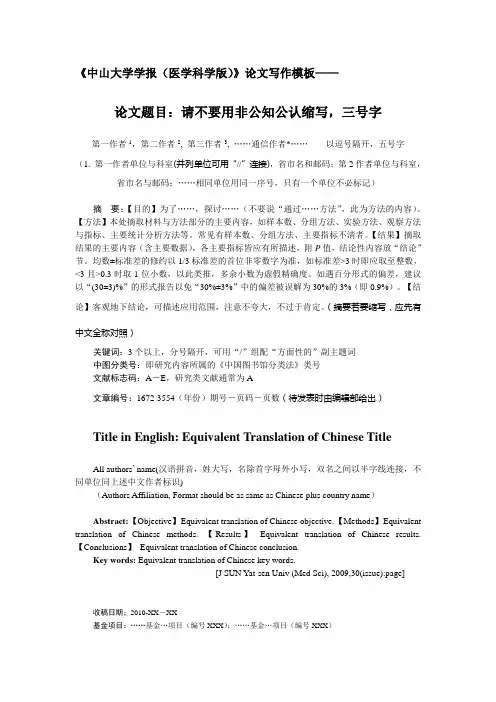
《中山大学学报(医学科学版)》论文写作模板——论文题目:请不要用非公知公认缩写,三号字第一作者1,第二作者2, 第三作者3, ……通信作者*……以逗号隔开,五号字(1. 第一作者单位与科室(并列单位可用“//”连接),省市名和邮码;第2作者单位与科室,省市名与邮码;……相同单位用同一序号,只有一个单位不必标记)摘要:【目的】为了……,探讨……(不要说“通过……方法”,此为方法的内容)。
【方法】本处摘取材料与方法部分的主要内容,如样本数、分组方法、实验方法、观察方法与指标、主要统计分析方法等。
常见有样本数、分组方法、主要指标不清者。
【结果】摘取结果的主要内容(含主要数据),各主要指标皆应有所描述,附P值,结论性内容放“结论”节。
均数±标准差的修约以1/3标准差的首位非零数字为准,如标准差>3时即应取至整数,<3且>0.3时取1位小数,以此类推,多余小数为虚假精确度。
如遇百分形式的偏差,建议以“(30±3)%”的形式报告以免“30%±3%”中的偏差被误解为30%的3%(即0.9%)。
【结论】客观地下结论,可描述应用范围,注意不夸大,不过于肯定。
(摘要若要缩写,应先有中文全称对照)关键词:3个以上,分号隔开,可用“/”组配“方面性的”副主题词中图分类号:即研究内容所属的《中国图书馆分类法》类号文献标志码:A-E,研究类文献通常为A文章编号:1672-3554(年份)期号-页码-页数(待发表时由编辑部给出)Title in English: Equivalent Translation of Chinese TitleAll authors’ name(汉语拼音,姓大写,名除首字母外小写,双名之间以半字线连接,不同单位同上述中文作者标识)(Authors Affiliation, Format should be as same as Chinese plus country name)Abstract: 【Objective】Equivalent translation of Chinese objective. 【Methods】Equivalent translation of Chinese methods. 【Results】Equivalent translation of Chinese results. 【Conclusions】Equivalent translation of Chinese conclusion.Key words: Equivalent translation of Chinese key words.[J SUN Yat-sen Univ (Med Sci), 2009,30(issue):page]收稿日期;2010-XX-XX基金项目:……基金…项目(编号XXX);……基金…项目(编号XXX)作者简介:第一作者姓名,学位,职称,研究方向:……,电子邮箱(E-mail),联系电话(编辑部联系专用)及其它必要说明的事项;*通信作者,通信作者姓名,E-mail,其他要说明的事项;其他要注明的作者引言部分应介绍本研究的科学背景(如某病的一两句话简介)、研究的国内外现状(如该病在本研究主题的国内外进展与尚待研究的内容)、本研究的创新点(本研究弥补或确证了国内外研究的哪方面),并引用文献佐证。
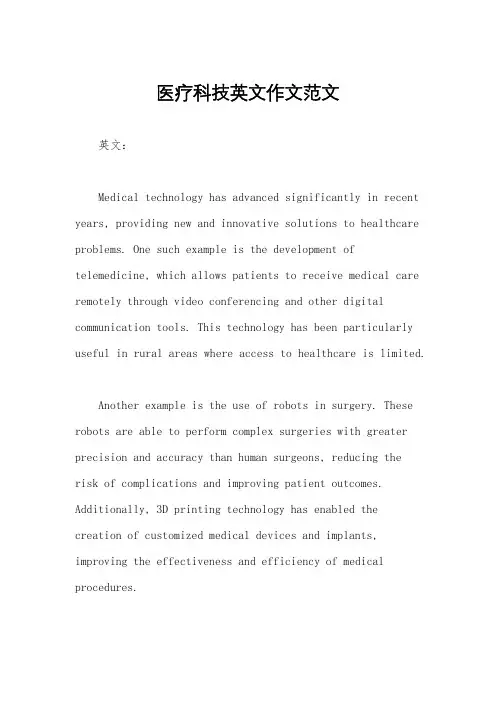
医疗科技英文作文范文英文:Medical technology has advanced significantly in recent years, providing new and innovative solutions to healthcare problems. One such example is the development of telemedicine, which allows patients to receive medical care remotely through video conferencing and other digital communication tools. This technology has been particularly useful in rural areas where access to healthcare is limited.Another example is the use of robots in surgery. These robots are able to perform complex surgeries with greater precision and accuracy than human surgeons, reducing therisk of complications and improving patient outcomes. Additionally, 3D printing technology has enabled thecreation of customized medical devices and implants, improving the effectiveness and efficiency of medical procedures.However, with the benefits of medical technology come ethical considerations. For example, the use of artificial intelligence in medical diagnosis and treatment raises questions about the role of human decision-making in healthcare. It is important to balance the potential benefits of technology with the need for human compassion and empathy in healthcare.Overall, medical technology has the potential togreatly improve healthcare outcomes, but it is important to approach its use with caution and consideration for ethical implications.中文:近年来,医疗技术取得了显著进步,为医疗问题提供了新的创新解决方案。
发医学论文范文精选3篇(全文) 医学论文撰写的步骤科学工作的最后环节就是撰写科研论文。
在写作之前,应将实验数据逐项进行归纳、整理与分析,并查阅收集有关的文献,尤其是初学写作的XX,更应阅读、借鉴好的医学论文,然后开始:1构思构思是撰写论文的准备,也是开始。
它是XX对文章整体布局、要说明的论点以及依据进行阐明、安排和设计的过程。
其内容包括:文章如何开头,如何进一步引深,首尾如何相呼应,论据论证如何有效的说明主题以及各段落层次与主题之间的关系。
2提纲在反映思考,理清思路,并形成条目后,写出提纲。
提纲是论文的基本骨架,有了提纲,XX写起来就会目标明确,思路开通。
提纲的内容主要是按题题目、前言(文章的宗旨目的)、实验材料与方法、讨论与结论的顺序进行。
3写作在提纲拟定后,根据自己的思路,妥当安排内容的先后次序,然后将自己的观点充分表达。
在写作初稿时,不妨内容写的全一些,面宽一些,幸免有重要内容遗漏。
而且,最好能集中一段时间和精力,使文章一气呵成。
4修改在文章的初稿完成后,应征求各方面的意见,尤其是共同的工XX与指导者。
然后加以反复推敲并作细致的修改。
文章全部完成后,最好放置一段时间,再行修改。
"温故而知新"常可发现重要问题,因而需要多次修改。
修改的重点是:①篇幅压缩;②结构调整:期刊论文要求结构严谨、层次清楚、衔接得当、重点突出并有逻辑性;③语言修改:应具有准确性与可读性。
对于"国内首创"、"国内空白"应有确切的依据,并幸免应用"大约"、"可能"之类的字眼,还应幸免应用非专业术语;④内容修改:根据自己写作的意图或要论证的内容材料,使内容修改的更为翔实、观点明确、结构严谨、论据充足。
医学论文的发表XX撰写论文的目的是能够发表。
因而对投寄的期刊必须有所了解,做到"知己知彼"。
医学期刊按照批准的级别可分全国性、省市性等,按照学术水平可分成高级、中级与初级,按照内容可分成综合性、专业性以及文摘性。